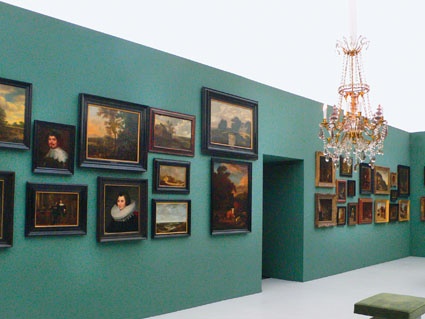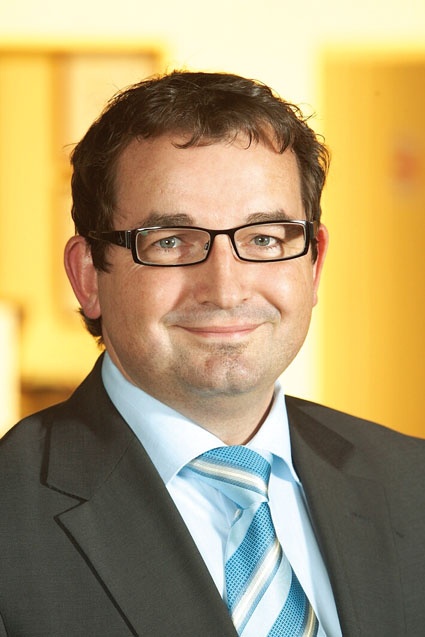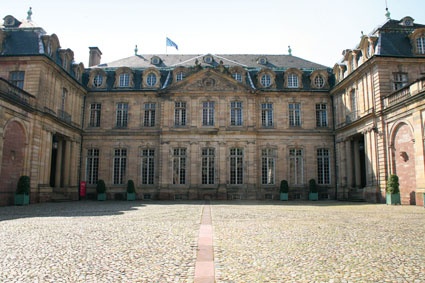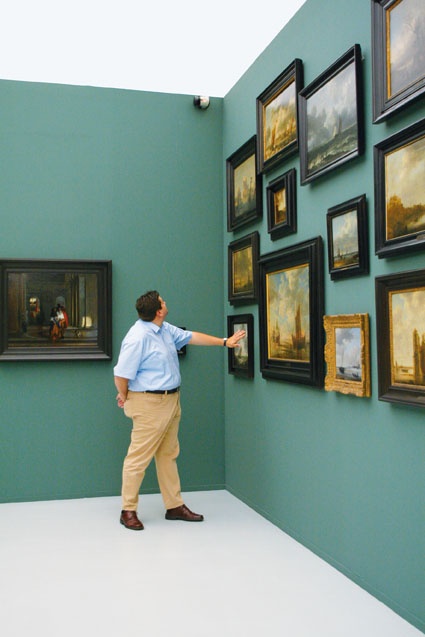Creative Monitoring
Visitors who cannot restrain their desire to touch, art thieves who are becoming more refined in response to rising prices on the art market, and acts of vandalism are increasingly...





Visitors who cannot restrain their desire to touch, art thieves who are becoming more refined in response to rising prices on the art market, and acts of vandalism are increasingly leading those in museum circles to consider how best to protect their works of art. LMS120 Laser Measurement Systems are the answer in numerous museums. As a result of their targeted but flexible area monitoring, they can reliably detect theft and vandalism - and thus pre-emptively prevent them - whilst reducing the number of guards.
The devices generate a dimensionally accurate, invisible optical curtain in front of one or more exhibits - adapted to room geometries and the arrangement of artworks - providing an unrestricted view, but simultaneously rapidly and reliably detecting touching, damage or attempted theft. Whether for a permanent or visiting exhibition, the creativity of the monitoring scenarios possible is almost as great as that of the artists themselves. At the same time, the TÜV-tested LMS120, currently undergoing certification by the VdS (the German insurers' association), offers all the possibilities for integration in higher-ranking monitoring and alarm concepts.
The Building Security Solution in the Building Automation Sector
In the protection of buildings and their security, the laser measurement technology of the LMS120 has, in numerous cases, proved the ideal economical and technical solution. It minimises the risk of theft and damage to artworks without impairing visitors' views. The fact that the device is tamperproof is also important for users, as is the possibility of activating video monitoring and alarm systems via the volt-free relay outputs. Use of laser measurement technology achieves both optimum security for the exhibits and optimum utilisation of the resources available regarding the interaction between a museum's mechanical protective measures, electronic hazard-signalling equipment, and personnel/organisational measures.
Why Is the Monitoring of Exhibits with the LMS120 so Creative?
Almost no building security solution offers adaptation to the requirements of exhibit monitoring, spatial conditions, and differing day and night scenarios that is as versatile as the LMS120. This is made possible by the functional principle of the LMS120. The active scanner of the measurement system transmits invisible fan-shaped laser pulses with an angular resolution of 0.5° and scanning frequency of up to 50 Hz within a 270° angle and measures the time to reception of the reflections. This ensures gap-free monitoring. "Dark bodies" at night - with only a few per cent reflectivity of the emitted laser light - are just as reliably detected as persons in broad daylight. No supplementary illumination sources are necessary because the laser provides its own light. Regardless of the light relationships in a room, and effectively protected against strong light incidence or deliberate dazzling, the LMS120 Laser Measurement System thus offers maximum detection reliability at all times. And because the scanners operate within a low laser protection class they can neither injure persons nor cause any damage to the exhibits.
With all its functionalities, the LMS120 is itself a work of art. The basic housing is available in over 200 different colour tones (based on the RAL colour system). The device is small, consumes little power, and offers a power input of 9-30V, i.e. it is also ideal for mobile applications on service robots in museums, or building security systems, as a further creative form of monitoring.
The LMS operates without a supplementary IT infrastructure. Regardless of the size and geometry of a room or building, up to ten monitored fields can easily be set up via coded device access according to the size of each of the exhibits and their placement and arrangement on the wall within the fan of laser beams generated by the LMS120. Whereby the room architecture, close examination by art-lovers, and the reading of information about the exhibit is just as unimpaired as the cleaning work carried out below a painting or around a sculpture or installation after the museum has closed. At the same time, though, ensuring maximum security against removal, touching, the cutting out of a picture from its frame, or any other undesirable contact. Whereby Laser Measurement Systems permit the flexible utilisation of space and wall areas because any changes in the room structure, e.g. through the erection of walls, screens or sculptures, or the relocation of pictures of differing formats, can easily be taken into account. Thus temporary exhibitions with differing exhibits and rooms can also be simply and effectively protected. The LMS120 is also recommended for protecting display cabinets, as long as large areas are monitored. The advantages are particularly apparent with variable day and night switching. Thus, during the day, the interior of the display cabinet is protected whereas, during the night, any approach towards the cabinet triggers the alarm.
High Detection Reliability, Low Rate of Spurious and False Alarms
The time-of-flight of the emitted light pulses changes - leading to the triggering of an alarm signal - as soon as a person reaches into or enters the protective field. The double-pulse evaluation of the measurement points, combined with integrated distance measurement, makes field monitoring extremely stable and allows very precise localisation of any infringement of the field. As the system not only detects the person as such, but also their position in space, monitoring cameras can also be focused and guided (for tracking purposes) with pin-point accuracy via the LMS120. Decisively, persons intending theft or vandalism can thus be detected before they act and a guard alerted. Moreover, the course of the criminal can subsequently be reconstructed.
It is essential that the system prevents spurious triggering and false alarms in order to ensure a high level of acceptance of the protective function of the LMS120 amongst visitors and guards. On the one hand, this is achieved by limiting the monitored fields by means of programming, so that work in the room (e.g. the cleaning of floors beneath a picture, or an information plaque next to one) is permitted without triggering any alarm. On the other hand, the scanning sensor technology in the LMS120 is designed so robustly that, for example, heat changes, light, or radio waves cannot impair monitoring. The LMS120 also has an operating range of 18 m, so that the system - protected from inquisitive glances and out of range of persons - can be mounted out-of-reach within a room, safe from any tampering. This positioning potential also prevents any possible interference with the consideration of works of art. Curators and visitors will be grateful for this.
Palais de Rohan: Reliable Protection for Fine Arts
Works of art can now feel even more secure at the Museum of Fine Art at the Palais de Rohan in Strasbourg. SICK has installed LMS120 Laser Measurement Systems here to monitor the pictures to prevent vandalism. The stand-alone installation achieved with standard components - in collaboration with the French integrator Cegelec - triggers an acoustic alarm signal as soon as a visitor gets too close to the works of art. The Museum wants to reduce vandalism and even theft, and ensure that they are absolutely ruled out. As a result of the excellent supplementary properties of the LMS120 it is also possible to rapidly and accurately control installed cameras so that specific portrait pictures of the offender can now be produced. Contrary to the previous situation, with the LMS120 the French guards now each have not just one but four exhibition rooms in secure view. The LMS120 detects the entire 18 m long and 6 m high wall. The detection field only stops about 20 cm in front of the work of art, so that any approaching finger, ball-point pen or knife is detected. Only the entry and exit areas are cut out by the scanner - so that the visitors are not accompanied by alarm sirens when entering or leaving the exhibition room.
Building Exteriors. Also Suitable for Securing Open Spaces and Outer Skins
If it is hard enough to find simple, reliable detection systems that are highly tamperproof and have a low false alarm rate for interior areas, it is even more difficult for external areas. Which is why the LMS120 family of devices from SICK also includes a version suitable for outdoor use, with which objects and persons can be reliably detected in open spaces - regardless of the weather, time of day, or their size and surface properties. This version has an additional software module that also ensures the reliable detection of facades, roofs and open spaces in rain, snow or fog. Thus even the intention to break in, and thus damage a door, window or roof, can be detected in advance. Connection to a monitoring system can take place via Ethernet, RS 232 or CAN Bus. The CAN Bus interface also allows direct communication between two LMS120 units, offering completely new possibilities in the evaluation of monitored areas. Several signalling zones can be defined with the monitored field. Thus segmented alarm signals can be generated, e.g. layered for the increasing proximity of a person to the building. As a result of this information, it is possible to generate differing protective measures depending on the level of the threat to the building - from the triggering of a siren, through the alerting of a team of guards, to information provided to specific persons by SMS and e-mail. It is also possible to activate the alarm lighting of museum or company grounds, switch specific views for guards to examine on their monitors, and increase the recording rate of video monitors for easier identification of intruders, who can be identified on the basis of the video recordings of persons and vehicles remotely called-up via LAN and ISDN. This prevents trouble and reduces costs - something that the insurance sector greatly appreciates.
Summary
The LMS120 masters the art of non-contact and barrier-free protection of paintings and sculptures in museums. Its certified laser measurement offers maximum flexibility and supplementary advantages - in terms of both reduced stress for guards as well as integration in higher-ranking monitoring concepts. Whether indoors or outdoors - the highly tamperproof devices and the prevention of unnecessary false alarms ensures that this monitoring solution gains a high level of acceptance amongst both visitors and users as a monitoring system in building management.
most read

Integrated and Futureproof: Traka’s Next Chapter
Interview with Stefni Oliver on Traka’s Vision for the Future


Security management, building security & perimeter protection: the winners of category E at the GIT SECURITY AWARD 2026
GIT SECURITY AWARD 2026: Security management, building security & perimeter protection - an overview of the most innovative solutions


The Benefits of AI-based Video Surveillance Solutions for Sports Venues
Dallmeier Interview: Artificial intelligence Makes Stadiums Smarter







